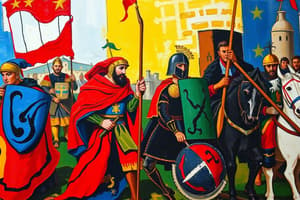Podcast
Questions and Answers
Define feudalism.
Define feudalism.
Feudalism is a way of organizing and governing society that developed after the fall of the Carolingian Empire, based on vassalage, fief, and serfdom.
Why did feudalism begin in the 9th and 10th centuries?
Why did feudalism begin in the 9th and 10th centuries?
Feudalism began in the 9th and 10th centuries due to the fall of Charlemagne's Empire and the invasions that devastated Europe, leading to a situation where kings relied on the nobility for protection and governance.
What is vassalage?
What is vassalage?
Vassalage was a pact of loyalty between monarchs and nobles where nobles provided military aid and loyalty in exchange for a fief.
Describe a fief.
Describe a fief.
Who were the serfs in the feudal system?
Who were the serfs in the feudal system?
Why did peasants fall into serfdom?
Why did peasants fall into serfdom?
Flashcards are hidden until you start studying
Study Notes
Definition of Feudalism
- Feudalism is a way of organizing and governing society that developed after the fall of the Carolingian Empire, based on vassalage, fief, and serfdom.
Causes of Feudalism
- Feudalism began in the 9th and 10th centuries due to the fall of Charlemagne's Empire and the invasions that devastated Europe.
- The kings were not strong enough to protect their kingdoms and relied on the nobility, who built castles and maintained an army.
Transformation of the Carolingian Empire
- The government system of the Empire created by Charlemagne was transformed, with counts becoming lords almost independent of the king.
- The power of the monarchs weakened, and the fiefdoms became hereditary and for life, leading to the beginning of feudalism in Europe.
Vassalage
- Vassalage was a "pact of loyalty" between monarchs and nobles, where the monarchs granted nobles a fief in exchange for loyalty and military aid.
- Feudal lords could grant part of their fiefs to other less powerful nobles, who would rule with a small army.
The Fief
- A fief or lordship was a set of lands in the hands of the nobility, where they exercised power and authority.
- The nobility had the right to exercise power and authority in their fiefs, including the lordship, demesne, and jurisdictional manor.
Serfdom
- Serfs were peasants who did not own their own land, worked on a lord's land, and had no personal freedom.
- They fell into serfdom to ensure their protection in a time of insecurity in Western Europe.
Studying That Suits You
Use AI to generate personalized quizzes and flashcards to suit your learning preferences.




